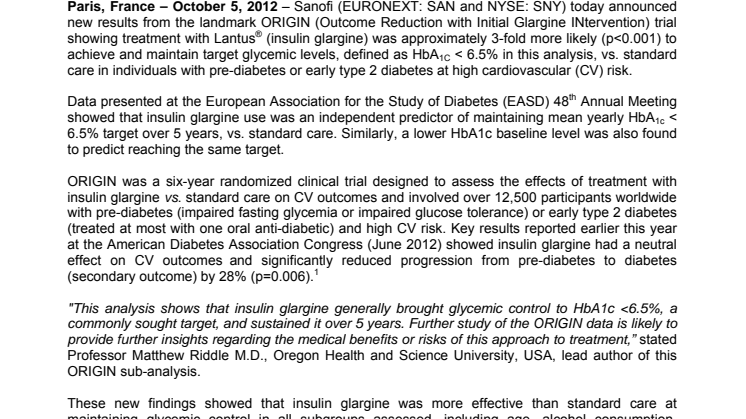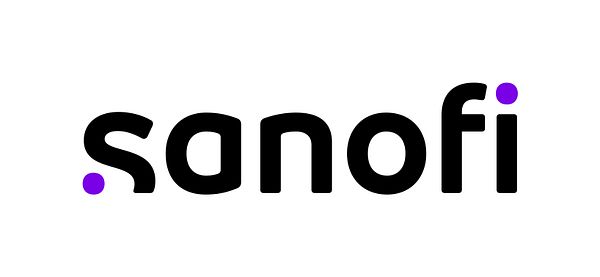Pressmeddelande -
New data from ORIGIN Shows Lantus® use is about 3 times more likely to achieve and sustain target HbA1c vs. standard care over 5 years in the study population
Paris, France – October 5, 2012 – Sanofi (EURONEXT: SAN and NYSE: SNY) today announced new results from the landmark ORIGIN (Outcome Reduction with Initial Glargine INtervention) trial showing treatment with Lantus® (insulin glargine) was approximately 3-fold more likely (p<0.001) to achieve and maintain target glycemic levels, defined as HbA1c < 6.5% in this analysis, vs. standard care in individuals with pre-diabetes or early type 2 diabetes at high cardiovascular (CV) risk.
Data presented at the European Association for the Study of Diabetes (EASD) 48th Annual Meeting showed that insulin glargine use was an independent predictor of maintaining mean yearly HbA1c < 6.5% target over 5 years, vs. standard care. Similarly, a lower HbA1c baseline level was also found to predict reaching the same target.
ORIGIN was a six-year randomized clinical trial designed to assess the effects of treatment with insulin glargine vs. standard care on CV outcomes and involved over 12,500 participants worldwide with pre-diabetes (impaired fasting glycemia or impaired glucose tolerance) or early type 2 diabetes (treated at most with one oral anti-diabetic) and high CV risk. Key results reported earlier this year at the American Diabetes Association Congress (June 2012) showed insulin glargine had a neutral effect on CV outcomes and significantly reduced progression from pre-diabetes to diabetes (secondary outcome) by 28% (p=0.006).1
"This analysis shows that insulin glargine generally brought glycemic control to HbA1c <6.5%, a commonly sought target, and sustained it over 5 years. Further study of the ORIGIN data is likely to provide further insights regarding the medical benefits or risks of this approach to treatment,” stated Professor Matthew Riddle M.D., Oregon Health and Science University, USA, lead author of this ORIGIN sub-analysis.
These new findings showed that insulin glargine was more effective than standard care at maintaining glycemic control in all subgroups assessed, including age, alcohol consumption, depression, baseline HbA1c, urine albumin:creatinine ratio (ACR), diabetes and particularly in individuals with abdominal obesity (p=0.011) and greater grip strength (p<0.001).
Dr. Riccardo Perfetti, Vice President Medical Affairs, Global Diabetes, Sanofi, commented: “Contrary to conventional understanding that diabetes is a progressively worsening disease, these new results from this sub-study of ORIGIN suggest that achieving and maintaining glycemic control early with insulin glargine might positively affect the natural history of the disease.”
Safety outcomes from the new ORIGIN sub-study were not included in the presentation at the EASD 48th Annual Meeting. Hypoglycemic events as observed in the ORIGIN main study1 were infrequent: In the insulin glargine arm, the rate of severe hypoglycemia was 0.01 episodes per patient-year of exposure versus 0.003 episodes per patient-year for standard care. Rates for overall hypoglycemia with insulin glargine were 16.7 patients with events per 100 patient-years of exposure versus 5.2 patients with events per 100 patient-years for standard care. In addition, weight gain was modest for participants in the insulin glargine arm, at an average of 3.5 pounds over the duration of the study.
In addition to more than 10 years of real life experience with Lantus® and clinical programs involving 80,000 people,2 ORIGIN and its sub-studies assert insulin glargine as the most studied basal insulin with long-term proven efficacy and established safety. Its indication is for the treatment of diabetes where insulin use is required; it does not include people with pre-diabetes.
About ORIGIN
ORIGIN (Outcome Reduction with Initial Glargine Intervention) is a unique, six-year landmark cardiovascular (CV) outcomes trial, evaluating Lantus® (insulin glargine) versus standard care in over 12,500 individuals who are at high CV risk with pre-diabetes or early type 2 diabetes mellitus. Spanning 40 countries worldwide, it is the world’s longest and largest randomized clinical trial of its type in this population, and the first to formally evaluate the effects of insulin on CV outcomes. The trial used a 2x2 factorial design to determine whether using insulin glargine to target fasting normoglycemia (FPG ≤ 95mg/dL), and separately omega-3 polyunsaturated fatty acids (PUFA), could reduce cardiovascular morbidity and/or mortality.3 Participants assigned to standard care were treated on the basis of the investigator’s best judgment and local guidelines, including lifestyle measures, dietary modifications, metformin, sulfonylureas and other oral anti-diabetic agents.
About Diabetes
Diabetes is a chronic disease that occurs in two main clinical presentations: type 1 diabetes, which is an autoimmune disease characterized by the lack of insulin (the hormone that regulates blood glucose concentrations) production by the pancreas, and type 2, a metabolic disorder in which there are two main biological defects: a deficient production of insulin and reduced ability of the body to respond to the insulin being produced. Type 1 and type 2 diabetes are characterized by an increase in blood glucose concentrations (hyperglycemia). Over time, uncontrolled hyperglycemia leads to the macrovascular and microvascular complications of diabetes. Macrovascular complications, which affect the large blood vessels, include heart attack, stroke and peripheral vascular disease. Microvascular complications affect the small blood vessels of the eyes (retinopathy), kidney (nephropathy) and nerves (neuropathy). Nearly 35 million people worldwide are living with type 1 diabetes. And, the incidence of type 2 diabetes is growing at an alarming rate, with more than 310 million people worldwide living with the condition today.
About Sanofi Diabetes
Sanofi strives to help people manage the complex challenge of diabetes by delivering innovative, integrated and personalized solutions. Driven by valuable insights that come from listening to and engaging with people living with diabetes, the Company is forming partnerships to offer diagnostics, therapies, services and devices, including innovative blood glucose monitoring systems. Sanofi markets both injectable and oral medications for people with type 1 or type 2 diabetes. Investigational compounds in the pipeline include an injectable GLP-1 receptor agonist being studied as a single agent, in combination with basal insulin, and/or in combination with oral antidiabetic agents.
About Sanofi
Sanofi, a global and diversified healthcare leader, discovers, develops and distributes therapeutic solutions focused on patients’ needs. Sanofi has core strengths in the field of healthcare with seven growth platforms: diabetes solutions, human vaccines, innovative drugs, consumer healthcare, emerging markets, animal health and the new Genzyme. Sanofi is listed in Paris (EURONEXT: SAN) and in New York (NYSE: SNY).
References
1. Gerstein H (ORIGIN Trail Investigators) et al. Basal Insulin and Cardiovascular and Other Outcomes in Dysglycemia. New England Journal of Medicine 2012; 367: 319-328.
2. Data on file
3. ORIGIN Trial Investigators, Gerstein H, Yusuf S, et al. Rationale, design, and baseline characteristics for a large international trial of cardiovascular disease prevention in people with dysglycemia: the ORIGIN Trial (Outcome Reduction with an Initial Glargine Intervention). Am Heart J 2008;155(1): 26-32.
Forward Looking Statements
This press release contains forward-looking statements as defined in the Private Securities Litigation Reform Act of 1995, as amended. Forward-looking statements are statements that are not historical facts. These statements include projections and estimates and their underlying assumptions, statements regarding plans, objectives, intentions and expectations with respect to future financial results, events, operations, services, product development and potential, and statements regarding future performance. Forward-looking statements are generally identified by the words “expects”, “anticipates”, “believes”, “intends”, “estimates”, “plans” and similar expressions. Although Sanofi’s management believes that the expectations reflected in such forward-looking statements are reasonable, investors are cautioned that forwardlooking information and statements are subject to various risks and uncertainties, many of which are difficult to predict and generally beyond the control of Sanofi, that could cause actual results and developments to differ materially from those expressed in, or implied or projected by, the forward-looking information and statements. These risks and uncertainties include among other things, the uncertainties inherent in research and development, future clinical data and analysis, including post marketing, decisions by regulatory authorities, such as the FDA or the EMA, regarding whether and when to approve any drug, device or biological application that may be filed for any such product candidates as well as their decisions regarding labelling and other matters that could affect the availability or commercial potential of such product candidates, the absence of guarantee that the product candidates if approved will be commercially successful, the future approval and commercial success of therapeutic alternatives, the Group’s ability to benefit from external growth opportunities, trends in exchange rates and prevailing interest rates, the impact of cost containment policies and subsequent changes thereto, the average number of shares outstanding as well as those discussed or identified in the public filings with the SEC and the AMF made by Sanofi, including those listed under “Risk Factors” and “Cautionary Statement Regarding Forward-Looking Statements” in Sanofi’s annual report on Form 20-F for the year ended December 31, 2011. Other than as required by applicable law, Sanofi does not undertake any obligation to update or revise any forward-looking information or statements.
Contacts:
Corporate Media Relations
Marisol Peron
Tel.: +33 1 53 77 45 02
Mobile: +33 6 08 18 94 78
E-mail: mr@sanofi.com
Investor Relations
Sébastien Martel
Tel.: + 33 1 53 77 45 45
E-mail: ir@sanofi.com
Global Diabetes Communications
Tilmann Kiessling
Mobile: +49 17 26 15 92 91
E-mail: Tilmann.Kiessling@sanofi.com


